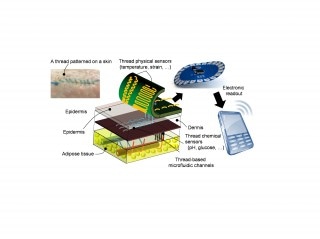Jul 18 2016
A team of researchers guided by Tufts University engineers have managed to combine nano-scale sensors, microfluidics and electronics into threads for the first time.
 Threads penetrate multiple layers of tissue to sample interstitial fluid and direct it to sensing threads that collect data, such as pH and glucose levels. Conductive threads then deliver the data to a flexible wireless transmitter sitting on top of the skin. The inset figure, upper left, shows liquid flowing in threads sutured into skin. (Credit: Nano Lab, Tufts University)
Threads penetrate multiple layers of tissue to sample interstitial fluid and direct it to sensing threads that collect data, such as pH and glucose levels. Conductive threads then deliver the data to a flexible wireless transmitter sitting on top of the skin. The inset figure, upper left, shows liquid flowing in threads sutured into skin. (Credit: Nano Lab, Tufts University)
The threads, ranging from simple cotton to advanced synthetics, can be sutured through several layers of tissue to collect diagnostic data wirelessly in real time. The details of this research have been published online in Microsystems & Nanoengineering on July 18.
According to the research, the thread-based diagnostic platform could be a useful substrate for smart wearable systems and advanced implantable diagnostic instruments.
The team used various conductive threads that were dipped in chemical and physical sensing compounds and connected to wireless electronic circuitry to develop a flexible system which was subsequently sutured into tissue in rats in addition to in vitro.
The threads gathered data on tissue health such as stress, strain, pressure, and temperature, glucose and pH levels that can be used to establish things such as a method to heal a wound, checking if infection is starting, or if the body’s chemistry is not in balance. The results were conveyed wirelessly to a computer and cell phone.
The 3D platform is able to comply with intricate structures such as wounds, organs, or orthopedic implants.
While more research is required in many areas such as examination of long-term biocompatibility, the researchers explain that the preliminary results increase the prospect of improving patient-specific treatments.
The ability to suture a thread-based diagnostic device intimately in a tissue or organ environment in three dimensions adds a unique feature that is not available with other flexible diagnostic platforms. We think thread-based devices could potentially be used as smart sutures for surgical implants, smart bandages to monitor wound healing, or integrated with textile or fabric as personalized health monitors and point-of-care diagnostics.
Sameer Sonkusale, Ph.D., Director of the Interdisciplinary Nano Lab, Department of Electrical and Computer Engineering, Tufts University’s School of Engineering
According to the paper, so far, the structure of substrates for implantable devices has fundamentally been 2D, restricting their efficacy to flat tissue such as skin. Furthermore, the materials in those substrates are costly and need dedicated processing.
“By contrast, thread is abundant, inexpensive, thin and flexible, and can be easily manipulated into complex shapes,” said Pooria Mostafalu, Ph.D., first author on the paper who was a doctoral student at Tufts when he worked on the project and is now a postdoctoral research fellow with the Harvard-MIT Division of Health Sciences and Technology, Brigham and Women’s Hospital, and the Wyss Institute for Biologically Inspired Engineering at Harvard University. “Additionally, analytes can be delivered directly to tissue by using thread’s natural wicking properties.”
The paper’s co-authors include Kyle A. Alberti and Qiaobing Xu, both of the Tufts University Department of Biomedical Engineering; Mohsen Akbari and Ali Khademhosseini, both of Harvard Medical School’s Biomaterials Innovation Research Center, the Harvard-MIT Division of Health Science and Technology and Harvard University’s Wyss Institute for Biologically Inspired Engineering. Khademhosseini is also affiliated with King Abdulaziz University’s Department of Physics.
The research was supported partially by the National Science Foundation Emerging Frontiers in Research and Innovation (EFRI) through grant number EFRI-1240443.